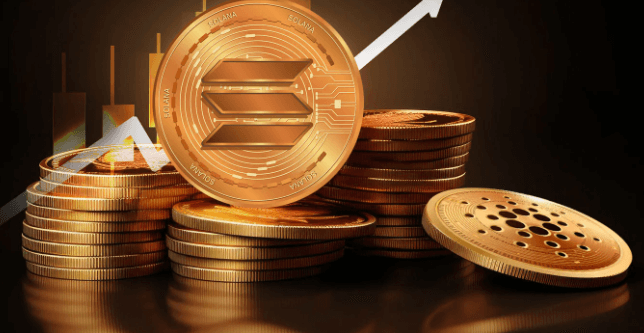Solana Experiences Notable Uptick: Outshines Ethereum as Its Value Soars

Recently, Solana has distinguished itself in the cryptocurrency market, outperforming its peers with a significant 7% increase in value early Wednesday.
Solana, after a brief lull following its impressive November surge, has reclaimed its position as the top-performing digital currency among the top 20 by market cap. As of this report, Solana (SOL) is priced at $60.16 per coin, marking a substantial 24-hour increase of over 7%, as per CoinGecko data. In the last week alone, SOL’s value has risen by 10%.
November witnessed a remarkable surge in Solana’s value, as it surpassed the $50 mark for the first time since May 2022, outpacing a majority of its counterparts in the crypto market. Market analysts attribute this surge to a combination of a short squeeze, triggered by short sellers withdrawing their bets, and increased institutional interest. Despite being a month old, this momentum in Solana’s value continues.
SOL’s recent price boost comes after it was heavily sold off following speculation that FTX’s new management might sell large quantities of SOL. The price surged as short sellers quickly closed their positions. In the past month, SOL’s value has escalated by over 70%.
The broader crypto market, however, remains relatively stagnant. Bitcoin and Ethereum have shown minimal movement over the past 24 hours. Similarly, other major cryptocurrencies like Dogecoin, Tron, and XRP have experienced negligible changes.
Bitcoin did see notable price activity recently, breaking past the $38,000 mark twice within a week. Avalanche is another digital asset that has shown positive movement, with AVAX price experiencing a 30-day gain of 80%. Its recent price increase follows J.P. Morgan’s use of its blockchain for tokenizing portfolios.
USDC goes wild
Solana’s blockchain has also seen a significant uptick in USDC transactions. This increase in stablecoin transfers, along with a rise in decentralized exchange (DEX) trading volumes, suggests a continued upward trend for Solana’s value.
In November, the USDC transfer volume on Solana’s network reached $71 million, a six-month high. This coincided with a peak in trading volumes for the cryptocurrency on DEXes.
Data from DeFiLlama indicates a spike in DEX trading volume in October, reaching new heights in November. This heightened trading activity in Solana-based DEXes has coincided with notable gains for SOL holders.
These developments hint at a resurgence of investor interest in the Solana ecosystem, potentially sustaining the cryptocurrency’s recent price appreciation. In the last month, SOL has provided a 77.70% return to its investors.
Circle co-founder and CEO Jeremy Allaire commented on the increased USDC transactions on Solana, viewing it as a positive sign for the development of the USDC ecosystem on this platform.
What is Solana?
Solana’s network, beyond its role as a platform for cryptocurrency transactions, offers a diverse range of applications. It is renowned for its high-speed and low-cost transactions, making it an ideal choice for decentralized finance (DeFi) applications. This includes lending platforms, decentralized exchanges, and yield farming, which allow users to lend, trade, and optimize their cryptocurrency holdings in a decentralized manner.
Additionally, Solana supports a wide array of decentralized applications (dApps) and smart contracts, enabling developers to create and deploy innovative blockchain-based solutions. Its scalability and efficiency also make it a popular choice for non-fungible token (NFT) marketplaces, where users can create, buy, and sell digital collectibles with ease. The combination of these features makes Solana a versatile and robust platform, suitable for various blockchain and cryptocurrency-related activities.
Not all shiny
Despite its many strengths, Solana’s network has faced criticism due to several notable outages, impacting its reliability and user trust. These disruptions, ranging from partial to complete network stoppages, have been attributed to various factors including resource exhaustion caused by high transaction loads, DDoS attacks, and software bugs. Such outages have temporarily halted transactions and dApp operations, causing inconvenience to users and developers on the network.
These incidents have highlighted challenges in Solana’s scalability and infrastructure robustness, prompting the Solana community and its developers to focus on improving network stability and resilience. Addressing these issues is crucial for maintaining Solana’s competitiveness in the rapidly evolving blockchain ecosystem, where reliability is as important as speed and efficiency.
Competitive environment
Solana, while unique in its offerings, faces competition from several other prominent blockchain platforms. Ethereum, often regarded as its main competitor, leads in decentralized applications and smart contract capabilities, despite higher transaction costs and lower speed. Ethereum’s upcoming upgrades aim to address these issues, intensifying the competition.
Binance Smart Chain (BSC) is another rival, known for its low transaction fees and high throughput, attracting a substantial user base and developers. Cardano, with its strong focus on academic research and formal verification, offers a more secure and sustainable blockchain solution, appealing to a different segment of users and developers. Lastly, Polkadot stands out with its interoperability feature, allowing different blockchains to connect and transfer data and value in a trust-free fashion.
